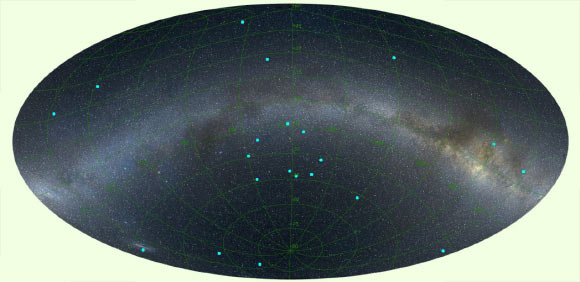A team of astronomers from Hungary and the United States has announced the discovery of the largest regular formation in the observable Universe – a ring with a diameter of 5.6 billion light-years, displayed by 9 gamma ray bursts (GRBs), and hence galaxies.

An image of the distribution of GRBs on the sky at a distance of 9 billion light-years, centered on the newly-discovered ring-like structure; the positions of the GRBs are marked by blue dots, and the Milky Way is indicated for reference, running from left to right across the image. Image credit: Lajos Balazs.
GRBs are short-lived and luminous flashes of gamma-rays from space associated with energetic explosions that have been observed in far-off galaxies. They can last from a few milliseconds to several minutes and come from random directions of the sky.
The GRBs that make up the newly-discovered ring-like structure were observed using space- and ground-based telescopes. They appear to be at very similar distances from us – around 9 billion light years – in a circle 36 degrees across on the sky, or more than 70 times the diameter of the full Moon.
This implies that the ring is more than 5 billion light-years across, and, according to the team, there is only a 1 in 20,000 probability of the GRBs being in this distribution by chance.
Most current models indicate that the structure of the cosmos is uniform on the largest scales. This ‘Cosmological Principle’ is backed up by observations of the early Universe and its microwave background signature. Other recent results and this new discovery challenge the principle, which sets a theoretical limit of 1.2 billion light-years for the largest structures.
“If the ring represents a real spatial structure, then it has to be seen nearly face-on because of the small variations of GRB distances around the object’s center,” said Prof Lajos Balazs of Konkoly Observatory in Budapest, first author of a paper published in the Monthly Notices of the Royal Astronomical Society (arXiv.org preprint).
“The ring could though instead be a projection of a sphere, where the GRBs all occurred within a 250 million year period, a short timescale compared with the age of the Universe.”
A spheroidal ring projection would mirror the strings of clusters of galaxies seen to surround voids in the Universe.
Voids and string-like formations are seen and predicted by many models of the cosmos. The newly-discovered ring-shaped feature is however at least 10 times larger than known voids.
“If we are right, this structure contradicts the current models of the Universe. It was a huge surprise to find something this big – and we still don’t quite understand how it came to exist at all,” Prof Balazs said.
The astronomers now plan to find out more about the ring, and establish whether the known processes for galaxy formation and large scale structure could have led to its creation, or if scientists need to radically revise their theories of the evolution of the cosmos.
_____
L.G. Balázs et al. 2015. A giant ring-like structure at 0.78 < z < 0.86 displayed by GRBs. MNRAS 452 (3): 2236-2246; doi: 10.1093/mnras/stv1421







